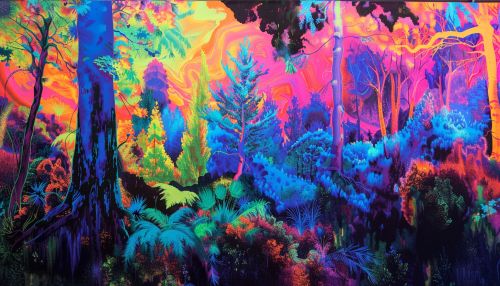The Doors of Perception: Difference between revisions
(Created page with "== Overview == "The Doors of Perception" is a philosophical work that delves into the nature of human consciousness and perception, primarily through the lens of altered states induced by psychoactive substances. The title is derived from a quote by William Blake: "If the doors of perception were cleansed, everything would appear to man as it is, infinite." This article explores the various dimensions of perception, the impact of psychoactive substances on human cognitio...") |
No edit summary |
||
| (One intermediate revision by the same user not shown) | |||
| Line 22: | Line 22: | ||
Psilocybin is a naturally occurring psychedelic compound found in certain species of mushrooms. It has been used in various cultural and religious contexts for its mind-altering effects. Psilocybin induces changes in perception, mood, and thought processes, often described as mystical or transcendent experiences. Recent studies have explored its potential therapeutic applications in treating mental health disorders. | Psilocybin is a naturally occurring psychedelic compound found in certain species of mushrooms. It has been used in various cultural and religious contexts for its mind-altering effects. Psilocybin induces changes in perception, mood, and thought processes, often described as mystical or transcendent experiences. Recent studies have explored its potential therapeutic applications in treating mental health disorders. | ||
[[Image:Detail-96171.jpg|thumb|center|A vibrant, colorful forest scene with exaggerated colors and patterns, resembling a psychedelic experience.|class=only_on_mobile]] | |||
[[Image:Detail-96172.jpg|thumb|center|A vibrant, colorful forest scene with exaggerated colors and patterns, resembling a psychedelic experience.|class=only_on_desktop]] | |||
== Neurobiological Mechanisms == | == Neurobiological Mechanisms == | ||
Latest revision as of 09:48, 4 July 2024
Overview
"The Doors of Perception" is a philosophical work that delves into the nature of human consciousness and perception, primarily through the lens of altered states induced by psychoactive substances. The title is derived from a quote by William Blake: "If the doors of perception were cleansed, everything would appear to man as it is, infinite." This article explores the various dimensions of perception, the impact of psychoactive substances on human cognition, and the broader implications for understanding reality.
Historical Context
The concept of altered perception has intrigued philosophers, scientists, and artists for centuries. The term "doors of perception" gained significant popularity after the publication of Aldous Huxley's book of the same name in 1954. Huxley's work was inspired by his experiences with mescaline, a psychoactive compound found in the peyote cactus. His observations and reflections provided a profound insight into the potential of human consciousness.
Theoretical Foundations
Perception and Reality
Perception is the process by which sensory information is interpreted by the brain to form a coherent representation of the external world. This involves complex interactions between sensory organs, neural pathways, and cognitive processes. Theories of perception often explore the distinction between objective reality and subjective experience. Philosophers such as Immanuel Kant and René Descartes have contributed significantly to this discourse, questioning the reliability of sensory information and the nature of reality.
Altered States of Consciousness
Altered states of consciousness (ASC) refer to any condition significantly different from a normal waking state. These can be induced by various means, including meditation, hypnosis, sleep, and psychoactive substances. ASCs are characterized by changes in perception, cognition, and emotional state. Research in this field has been instrumental in understanding the plasticity of the human mind and the potential for expanded consciousness.
Psychoactive Substances and Perception
Mescaline
Mescaline is a naturally occurring psychedelic alkaloid found in certain cacti, such as peyote and San Pedro. It has been used for centuries in indigenous rituals and ceremonies. Mescaline induces profound alterations in perception, often described as enhanced colors, patterns, and a sense of interconnectedness. Huxley's experiences with mescaline formed the basis of his exploration in "The Doors of Perception."
LSD (Lysergic Acid Diethylamide)
LSD is a synthetic compound known for its potent psychoactive effects. Discovered by Albert Hofmann in 1938, LSD gained popularity in the 1960s counterculture movement. It profoundly affects perception, leading to visual hallucinations, altered sense of time, and ego dissolution. Research into LSD has provided valuable insights into the neurochemical basis of perception and consciousness.
Psilocybin
Psilocybin is a naturally occurring psychedelic compound found in certain species of mushrooms. It has been used in various cultural and religious contexts for its mind-altering effects. Psilocybin induces changes in perception, mood, and thought processes, often described as mystical or transcendent experiences. Recent studies have explored its potential therapeutic applications in treating mental health disorders.


Neurobiological Mechanisms
Serotonin Receptors
Psychoactive substances such as mescaline, LSD, and psilocybin primarily interact with serotonin receptors in the brain, particularly the 5-HT2A receptor. Activation of these receptors leads to altered neural activity, resulting in changes in perception and cognition. Understanding the role of serotonin receptors has been crucial in elucidating the mechanisms underlying altered states of consciousness.
Default Mode Network (DMN)
The Default Mode Network (DMN) is a network of brain regions that are active during rest and self-referential thought. Altered states of consciousness often involve a disruption of the DMN, leading to a breakdown of the usual patterns of thought and perception. This disruption is associated with experiences of ego dissolution and a sense of unity with the environment.
Philosophical Implications
Phenomenology
Phenomenology is the philosophical study of the structures of experience and consciousness. It seeks to describe phenomena as they are perceived, without preconceived notions. The exploration of altered states of consciousness provides a unique perspective on phenomenology, challenging traditional views of perception and reality.
Epistemology
Epistemology is the study of knowledge, its nature, and its limits. Altered states of consciousness raise important epistemological questions about the reliability of sensory information and the nature of reality. If perception can be so profoundly altered, what does this imply about our understanding of the world?
Metaphysics
Metaphysics explores the fundamental nature of reality, including the relationship between mind and matter. The experiences induced by psychoactive substances often lead to metaphysical reflections on the nature of existence, consciousness, and the interconnectedness of all things.
Cultural and Societal Impact
Indigenous Practices
Many indigenous cultures have long traditions of using psychoactive substances in religious and healing practices. These substances are often considered sacred and are used to facilitate spiritual experiences and communication with the divine. Understanding these practices provides valuable insights into the cultural significance of altered states of consciousness.
Counterculture Movement
The 1960s counterculture movement saw a resurgence of interest in psychoactive substances, particularly LSD. This period was marked by a rejection of mainstream values and an exploration of alternative lifestyles and spiritual practices. The use of psychedelics played a significant role in shaping the cultural and social dynamics of the time.
Modern Therapeutic Applications
Recent research has explored the potential therapeutic applications of psychoactive substances in treating mental health disorders such as depression, anxiety, and PTSD. Clinical trials have shown promising results, leading to a renewed interest in the medical and scientific community. This represents a significant shift in the perception and acceptance of these substances.
Ethical Considerations
Informed Consent
The use of psychoactive substances in research and therapy raises important ethical considerations. Informed consent is crucial, ensuring that participants are fully aware of the potential risks and benefits. Researchers must adhere to strict ethical guidelines to protect the well-being of participants.
Legal and Regulatory Issues
The legal status of psychoactive substances varies widely across different countries and jurisdictions. Many of these substances are classified as controlled substances, limiting their availability for research and therapeutic use. Ongoing debates continue regarding the regulation and decriminalization of these substances.
Potential for Abuse
While psychoactive substances have therapeutic potential, they also carry the risk of abuse and addiction. It is essential to balance the benefits with the potential harms, implementing measures to minimize the risk of misuse. Public education and harm reduction strategies are critical components of this approach.
Future Directions
Neuroscientific Research
Advancements in neuroscience continue to shed light on the mechanisms underlying altered states of consciousness. Future research aims to further elucidate the neural correlates of perception and consciousness, paving the way for new therapeutic interventions.
Integration into Mainstream Medicine
As evidence supporting the therapeutic benefits of psychoactive substances grows, there is potential for their integration into mainstream medicine. This requires rigorous clinical trials, regulatory approval, and the development of standardized treatment protocols.
Societal Acceptance
The societal acceptance of psychoactive substances is evolving, influenced by changing cultural attitudes and scientific discoveries. Continued education and open dialogue are essential in fostering a more informed and balanced perspective on these substances.
